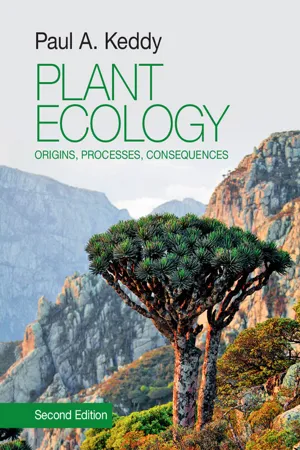
- English
- PDF
- Available on iOS & Android
About this book
Presenting a global and interdisciplinary approach to plant ecology, this much-awaited new edition of the book Plants and Vegetation integrates classical themes with the latest ideas, models, and data. Keddy draws on extensive teaching experience to bring the field to life, guiding students through essential concepts with numerous real-world examples and full-colour illustrations throughout. The chapters begin by presenting the wider picture of the origin of plants and their impact on the Earth, before exploring the search for global patterns in plants and vegetation. Chapters on resources, stress, competition, herbivory, and mutualism explore causation, and a concluding chapter on conservation addresses the concern that one-third of all plant species are at risk of extinction. The scope of this edition is broadened further by a new chapter on population ecology, along with extensive examples including South African deserts, the Guyana Highlands of South America, Himalayan forests and arctic alpine environments.
Frequently asked questions
- Essential is ideal for learners and professionals who enjoy exploring a wide range of subjects. Access the Essential Library with 800,000+ trusted titles and best-sellers across business, personal growth, and the humanities. Includes unlimited reading time and Standard Read Aloud voice.
- Complete: Perfect for advanced learners and researchers needing full, unrestricted access. Unlock 1.4M+ books across hundreds of subjects, including academic and specialized titles. The Complete Plan also includes advanced features like Premium Read Aloud and Research Assistant.
Please note we cannot support devices running on iOS 13 and Android 7 or earlier. Learn more about using the app.
Information

Table of contents
- Cover
- Half-title
- Title page
- Copyright information
- Epigraph
- Table of contents
- List of Boxes
- Preface
- 1 Plants Create the Biosphere
- 2 The Search for Global Patterns
- 3 Resources
- 4 Competition
- 5 Disturbance
- 6 Herbivory
- 7 Positive Interactions
- 8 Time
- 9 Populations
- 10 Stress
- 11 Gradients and Plant Communities
- 12 Diversity
- 13 Conservation and Management
- References
- Figure and Table Credits
- Glossary
- Index